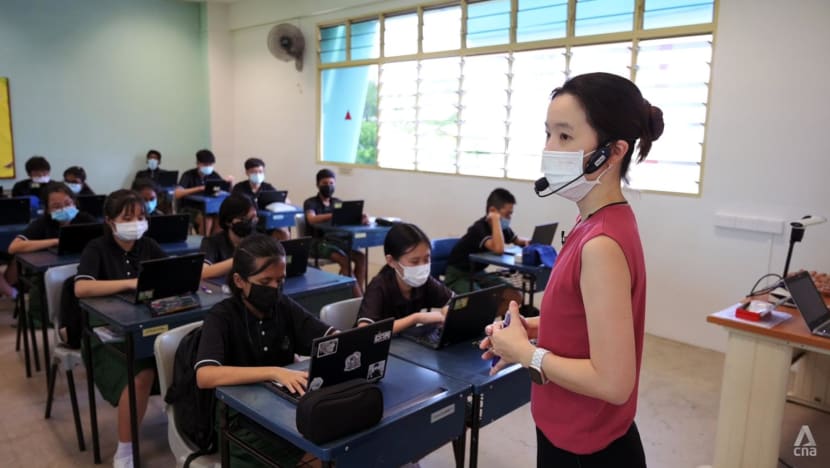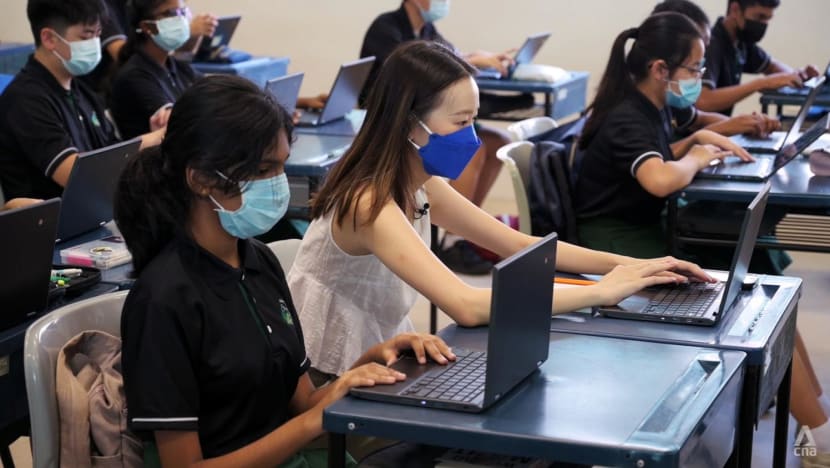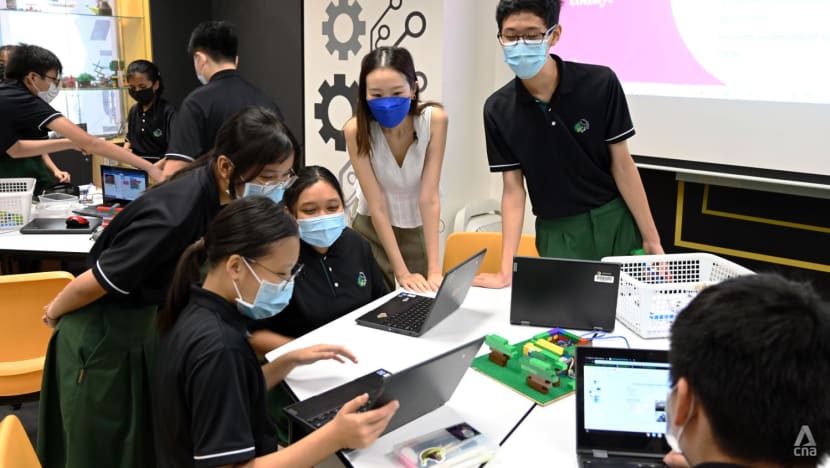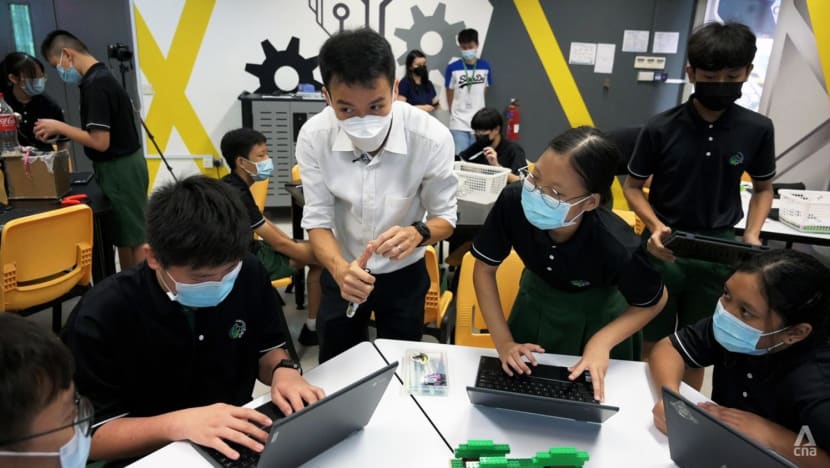Back to school: Googling, coding and Lego prototypes – this is what Science lessons are like today
In the last article of a three-part series looking at how teaching methods and lessons in Singapore's schools have evolved, CNA journalist Ang Hwee Min went back to the classroom to find out how Science lessons have changed.

CNA journalist Ang Hwee Min answers a question during a science lesson at Jurongville Secondary School. (Photo: CNA/Marcus Mark Ramos)
SINGAPORE: As the students of 2 Discipline at Jurongville Secondary School filed into the classroom and took their seats on a Friday morning, I was puzzled to see that almost none of them had any stationery or paper in front of them.
Instead, aside from eyeing me warily, most of them took out their tablet computers from their bags. As our teacher, Mrs Wong Yan Pure, started the Science lesson, I was still the only person in my class who had a notebook and pen on the table.
“So if you want to take notes, how do you write stuff down?” I asked my seatmate, Swathishrii Surash Kumar, hesitantly.
With a small smile that implied she thought I was out of touch with the youth of today, she replied: “I use Google Docs.” She then asked me to call her Swathi.
I am no stranger to online writing software, but I was surprised to find out that taking notes with paper and a pen is no longer the norm for kids these days. Thankfully, I scored my own tablet, or personal learning device, so I could become their classmate for the day.
Mrs Wong, who has been teaching for 15 years, started the lesson off by asking the class: “How do human activities impact the environment we are staying in now?”
“It can be your own small little impact, or you can think about the whole situation that the world is in now. What kind of impact do they have on the environment?”

Before I attended the class, I spoke with Madam Charlene Seah, a senior curriculum specialist for lower secondary science with the Ministry of Education (MOE), and she shared that there have been two main changes to the curriculum in the past 10 years or so.
“One is the strengthening of the interdisciplinary integration within science. And then the second part is to allow more opportunities for our students to problem seek and to develop their own explanations and solutions for some of these problems.”
Alongside these two changes, context has been introduced to the Science curriculum to provide more relevance and currency, she added.
“And how these contexts are selected is based on global issues that are related to science. So maybe sustainability, climate change, emerging technology,” said Mdm Seah.
In my lower secondary Science classes about 13 years ago, I remember sitting in class, listening to the teachers explain the theories behind interactions and phenomena like gravity, photosynthesis, energy production in cells, and so on.
While I always liked those classes, I would be hard-pressed to say that I really understood the significance of what I was learning in my lower secondary years.
What good did knowing about acidic and alkaline reactions do? I couldn’t tell you, at the age of 13 or 14. However, students today can tell you about the acidic reaction that occurs in the sky that produces acid rain and its environmental impact.
A new lower secondary Science curriculum was recently rolled out in 2021, and the current science curriculum framework was launched the year before, said the curriculum specialist.
Mdm Seah, who used to be a teacher herself, said the new curriculum is meant to help students appreciate that science is “not just a body of facts”, but a “meaningful human endeavour”.
“As they observe the phenomena around them, and as they use the items around them, they notice, and we hope that they’re prompted to consider that science and technology are useful and have the potential to solve challenges in daily life and society.”
Mrs Wong said she has observed that students are now less exam-driven.
“Ten years ago whatever we were learning, it’s really just like that. I also don’t really understand what I’m learning it for, but I just have to memorise,” she added.
“But in this new age, we really do need to know how to apply the content that we learnt. So the practical aspect, it’s not just practical, we really have to source for good and authentic tasks that students can embark on to make it more meaningful for the students.”
INQUIRE, INSPIRE AND INNOVATE
Back in class, everyone understood the meaning behind Mrs Wong’s question.
I almost expected her to walk around and point at random students for answers, as my own teachers did all those years ago. Instead, my classmates for the day were given a moment to ponder the question before submitting their answers on a programme on their learning devices, which then sent their answers to Mrs Wong’s projection on the screen.
I think this approach would have been more helpful for my classmates who were reluctant to speak up in school. Feeling a small sense of relief at not having to raise my hand, I keyed in my answer (waste production and overconsumption) into the white box on my screen. I peeped at Swathi’s computer as she keyed in her own answer, global warming.
As climate change-related phrases popped up in a word cloud on the screen, Mrs Wong took the class through some of the terms. She then turned to how climate change has affected Singapore, and what measures have been taken, as we went through another Q&A round.
I was pleasantly (or maybe not so pleasantly) surprised to hear topics I’ve covered in my work like the plastic bag charge at supermarkets, the One Million Trees movement, Singapore’s push for solar energy and Pulau Semakau’s lifespan coming up in Mrs Wong’s sharing.

USING THE WORLD WIDE WEB AS A TEXTBOOK
After our brief discussion in the first 10 minutes of class, Mrs Wong turned to our activity of the day: Making a biodegradable planter with eggshells, soil and a variety of seeds.
While issuing the instructions, she spoke about what using a biodegradable planter like an eggshell would mean when replanting the plant after it sprouts. She also explained the meaning and benefits of growing food organically.
As we waited for our row to be called to collect our materials, Swathi and I discussed which seed to pick. She told me that this was the first time they were working on a hands-on assignment in the classroom, and that most practical assignments take place in a laboratory.
After collecting the materials and covering up our sakura tomato seed in our eggshell planter with soil, I asked Swathi if she would mind if I wrote my name on the planter too, even though I was only going to be her classmate for a day. She kindly obliged.

We were then told to research what conditions the plant we chose needed to sprout and grow. Using our tablet computers, we searched online for answers.
As we were Googling away, Mrs Wong reminded the class about the different conditions needed for a plant to grow - water, sunlight, pH and nutrients. She quizzed them on how they would test for these conditions, and related them back to equipment they might be familiar with from the school science laboratory.
I’m an avid fan of Googling things I don’t know the answer to. But in this case, the entire World Wide Web was my textbook and I somehow felt incredibly empowered, though the situation was a little strange.
I wondered if my classmates felt the same way as I typed "sakura tomato what conditions needed to grow" into the Google search bar.
When I expressed this to Mrs Wong, she assured me that they still have textbooks that are still sometimes used in class. But in some settings, students are encouraged to define their own problems, and search for the corresponding solutions. For example, each pair in class would have chosen a different seed, and they would need to know what to search for to answer her question.
“If I really compare to our time, where it’s always very didactic, we learn what the teacher teach us, because we don’t really have access to the Internet. And then a lot of our sources are really just based on encyclopedias. But now because of the World Wide Web, they can actually access a lot of other things,” she said.
“So it’s really very important for students to know and to decipher whether the things they read on the Web, is it important? Is it correct? And how are we going to make use of this correct information to help solve certain problems that we have in our life.”
I also asked her about the open-ended way she phrased her questions - while she may have reminded them about what a plant may need to grow, she never told them what to search online.
“It’s important for students to be able to do their own research, being critical thinkers, in order to solve the problems that may come to them,” said Mrs Wong.
“I may not have all the answers, there are so many different types of plants. I really don’t know what is suitable. So I think it’s best for students to find out themselves.”
Learning about the real-world application of science in class “helps us grow into better adults”, said another classmate Damian Ooh.
As an animal lover, his favourite topic is the one we tackled on Friday - ecosystems.
“We’re learning about how all the animals adapted to the environment and how they live. It’s quite interesting to see how they’ve changed over time just to adapt to this specific environment for all of them to live in,” he shared.
Another classmate Allada Vasavya said she preferred the previous chapter on chemicals, as the class involved a lot of group work and practical lessons, which she found “very engaging”.

APPLIED LEARNING PROGRAMME
After the single period of Science class, I also sat in on Jurongville Secondary’s applied learning programme with 2 Discipline.
As class began, it became clear that the students had been working on their projects for a few weeks. Most students - in groups of 4 - had prototypes made out of Lego and other materials that were moving, beeping or flashing.
In the applied learning programme at this school, there is a focus on coding and electronics. Students are tasked with choosing a real-world problem, and then prototyping a solution for the problem using a Microbit, which is a mini programmable computer. They also need to present their project at the end of the term.
All mainstream MOE secondary schools offer their own applied learning programme, and slightly over half of them offer one in science, technology, engineering and mathematics (STEM), Mdm Seah shared. The applied learning programmes are available to all students in lower secondary, and interested students can continue to take it as an elective in upper secondary.
“It’s a non-examinable subject. It’s a lot of application learning, getting them to apply knowledge they have from different places, and specifically to link it to electronics,” said the class teacher Mr Lim Sien Long.
“Specifically what they learn is actually a mixture of programming, electric circuits and also designing, especially the design thinking process. So apart from being hands on, students also learn how to think in a logical and systematic manner. At the same time, they get to demonstrate their creativity as well.”
All this was very new to me, there was no coding at all when I was in school. The closest comparison I could think of was the ICT lessons we had. My school was lucky to be among the first to pilot tablet computers in 2009, and I will admit I spent most of my time in these lessons figuring out how to play online games with my friends.
SOLVING REAL PROBLEMS WITH PROTOTYPES
I sat with Damian and his group mates Anya Wong, Aniqah Nadirah and Nathan Cheng, and asked them to explain how the flashing contraption on their table was supposed to work.
Anya gleefully shared that their prototype was working successfully, and they were now finishing up their presentation slides.
“This is about measuring the noise level in an environment. Sometimes there are people illegally cutting down trees, causing noise pollution, or going hunting in a forest. So if the noise level is above 85db, this sensor will make the LED light up, to alert them that there is something wrong,” she explained eagerly.
Their prototype comprised a building in a forest, constructed out of Lego. There was a sound meter on the “outside” in the forest, which was connected to a Microbit and LED sign “inside” the building. I shouted at the prototype to set it off, and it worked, with a beeping alarm indicating that I had indeed violated the proposed noise restrictions.
“We wanted to solve the problem of noise pollution, but also detecting illegal human activities like hunting. So when they are doing those activities, the noise level will definitely increase,” Anya said, adding that the sensors placed in the forest would detect the noise.
If alerted to the illegal activity, authorities can then respond to the threat, she added. Another idea they had was to plant speakers in the forest, which would automatically go off with warnings if the noise threshold was reached.

The topic chosen for the applied learning programme this year was climate change, Mr Lim explained. At the lower secondary level, students have one hour of applied learning programme lessons per week for half a year, he added.
Students at Jurongville Secondary who are interested in electronics can carry on to take it as a subject in Secondary 3 and 4 at the Normal (Technical) and Express levels.
In the weeks leading up to this lesson, students learn how to use the Microbit and were introduced to basic coding logic. They also learned about different sensors and how to use them.
“Through that whole programme, it’s a slow build up of the knowledge to know what are the resources available. And then in the second part, it’s where we get them to actually take action. We give them a theme and then they work on identifying a problem, coming up with a solution for it through the design thinking process,” said Mr Lim.
The students “really do care” about making a change and the class is a “rich experience” for them, he added.
“Most subjects that I teach it’s driven by them wanting to do well in their grades, but this is really all pure motivation … Students not just demonstrate their creativity, they actually go beyond what they learn in class. There are some things that I never taught them, but they are able to use their resources to find online and try and get it to work,” said Mr Lim.
Damian enjoys the coding part of the project, and has been interested in coding since he attended coding lessons when he was younger.
“It’s really interesting how you can put something into a computer and you can make it work in real life. It really works my brain also when I try to think about the logic of coding,” he added.
As my four group members quibbled over who would present which part of their deck, I took a walk around the class to look at the other prototypes.
Allada showed me her group’s contraption - a machine that sorts big and small pieces of trash before they are recycled.
With a swinging arm to help sweep smaller pieces of trash away, the machine automatically stops when the arm is blocked by a larger piece of trash, she explained, as she dropped small and big pieces of Lego blocks to demonstrate this.

Her group came up with this idea because they all live in HDB flats, and noticed that the recycling bins below their blocks are always full. A contraption like theirs could help make recycling easier if the trash is sorted before it is taken to the recycling centre, she said.
She prefers the part where they have to build the prototype, adding that she was quite proud of her group’s contraption, she said.
“I’m not good at coding, so my other teammates help with the coding while I build it, which helps me think of different ways to make it better and easier to understand, when other people see what my prototype is.”
At the end of the lesson, I watched my four groupmates present their work. While it was nowhere as smooth as a university-level presentation, I was impressed at the considerations they had taken in choosing their problem and finding a solution.
With a focus on STEM and pressing issues like climate change featuring heavily in the curriculum, it was clear that the Education Ministry is hoping to prepare these students for what’s to come.
“I think when we teach children with context, it influences the resources we provide in our instructional materials, the kind of learning experiences that is shaped for the students,” Mdm Seah said, when I pointed this out.
“With all these opportunities … we hope that students have opportunities to make connections across the subjects, to connect to what they’ve been learning in school, with all these issues that are happening in their lives, as well as them being comfortable with problem-seeking, making them confident and willing to develop solutions to improve their lives.”
It remains to be seen if these students will be entirely ready for the challenges coming their way. Not all of them will go on to have careers in STEM, but I’m certain they will be more prepared to contribute to the real world than I was.
















